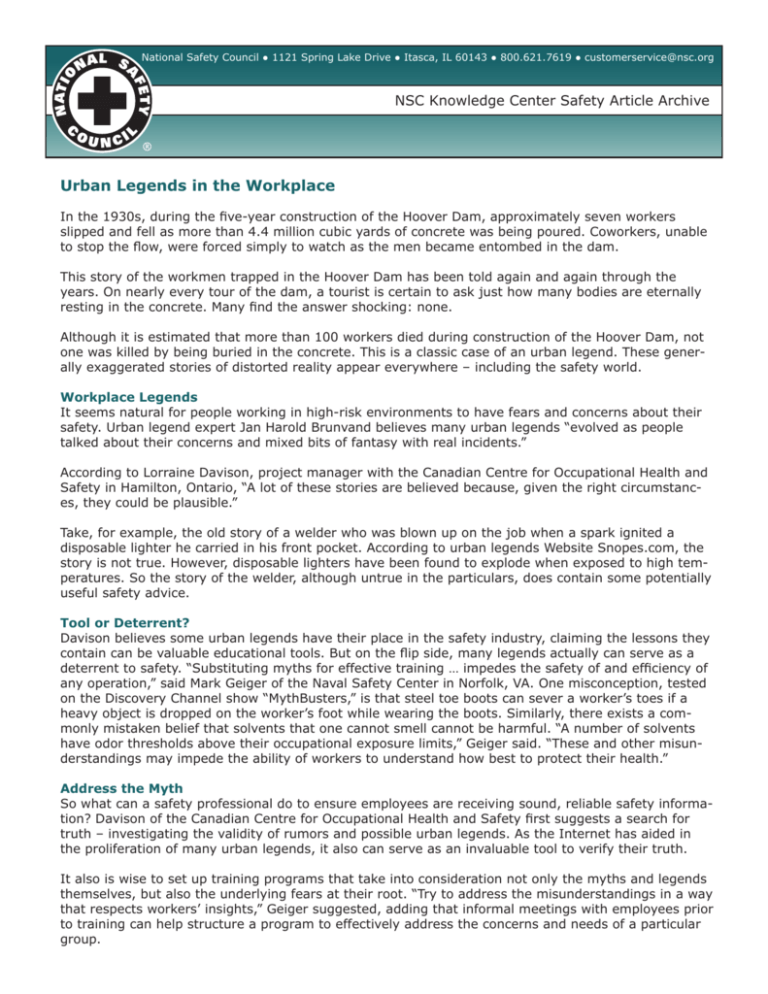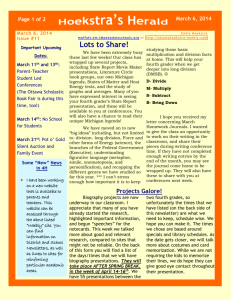
National Safety Council ● 1121 Spring Lake Drive ● Itasca, IL 60143 ● 800.621.7619 ● customerservice@nsc.org
NSC Knowledge Center Safety Article Archive
Urban Legends in the Workplace
In the 1930s, during the five-year construction of the Hoover Dam, approximately seven workers
slipped and fell as more than 4.4 million cubic yards of concrete was being poured. Coworkers, unable
to stop the flow, were forced simply to watch as the men became entombed in the dam.
This story of the workmen trapped in the Hoover Dam has been told again and again through the
years. On nearly every tour of the dam, a tourist is certain to ask just how many bodies are eternally
resting in the concrete. Many find the answer shocking: none.
Although it is estimated that more than 100 workers died during construction of the Hoover Dam, not
one was killed by being buried in the concrete. This is a classic case of an urban legend. These generally exaggerated stories of distorted reality appear everywhere – including the safety world.
Workplace Legends
It seems natural for people working in high-risk environments to have fears and concerns about their
safety. Urban legend expert Jan Harold Brunvand believes many urban legends “evolved as people
talked about their concerns and mixed bits of fantasy with real incidents.”
According to Lorraine Davison, project manager with the Canadian Centre for Occupational Health and
Safety in Hamilton, Ontario, “A lot of these stories are believed because, given the right circumstances, they could be plausible.”
Take, for example, the old story of a welder who was blown up on the job when a spark ignited a
disposable lighter he carried in his front pocket. According to urban legends Website Snopes.com, the
story is not true. However, disposable lighters have been found to explode when exposed to high temperatures. So the story of the welder, although untrue in the particulars, does contain some potentially
useful safety advice.
Tool or Deterrent?
Davison believes some urban legends have their place in the safety industry, claiming the lessons they
contain can be valuable educational tools. But on the flip side, many legends actually can serve as a
deterrent to safety. “Substituting myths for effective training … impedes the safety of and efficiency of
any operation,” said Mark Geiger of the Naval Safety Center in Norfolk, VA. One misconception, tested
on the Discovery Channel show “MythBusters,” is that steel toe boots can sever a worker’s toes if a
heavy object is dropped on the worker’s foot while wearing the boots. Similarly, there exists a commonly mistaken belief that solvents that one cannot smell cannot be harmful. “A number of solvents
have odor thresholds above their occupational exposure limits,” Geiger said. “These and other misunderstandings may impede the ability of workers to understand how best to protect their health.”
Address the Myth
So what can a safety professional do to ensure employees are receiving sound, reliable safety information? Davison of the Canadian Centre for Occupational Health and Safety first suggests a search for
truth – investigating the validity of rumors and possible urban legends. As the Internet has aided in
the proliferation of many urban legends, it also can serve as an invaluable tool to verify their truth.
It also is wise to set up training programs that take into consideration not only the myths and legends
themselves, but also the underlying fears at their root. “Try to address the misunderstandings in a way
that respects workers’ insights,” Geiger suggested, adding that informal meetings with employees prior
to training can help structure a program to effectively address the concerns and needs of a particular
group.
National Safety Council ● 1121 Spring Lake Drive ● Itasca, IL 60143 ● 800.621.7619 ● customerservice@nsc.org
NSC Knowledge Center Safety Article Archive
As an example, Geiger cites the reluctance some military personnel have felt toward using hearing
protection in combat situations, for fear of impairing their sensitivity to background noise. An open
understanding of these fears led to an alteration in the training to focus “on the long-term benefits of
hearing protection in routine operations to preserve this sensitivity.”
In this situation, the myth and the fear were addressed, training was modified in response and, as a
result, workers are safer. Awareness of not only what myths and legends exist, but also why they
exist, is critical to creating a safe work environment.
Copyright 2007 * National Safety Council * All Rights Reserved.
Content from the National Safety Council Members-Only Website is available for you to re-use for educational purposes through your internal employee communications.
We do ask that the National Safety Council is credited as follows, “Permission to reprint granted by the National Safety Council, a membership organization dedicated to
protecting life and promoting health” or “Copyright National Safety Council, All Rights Reserved”










